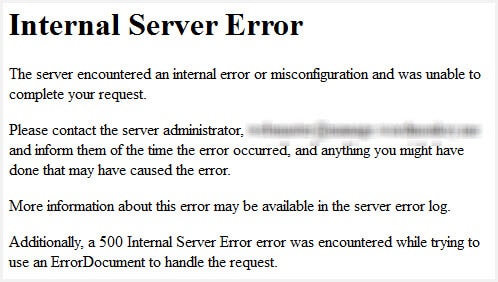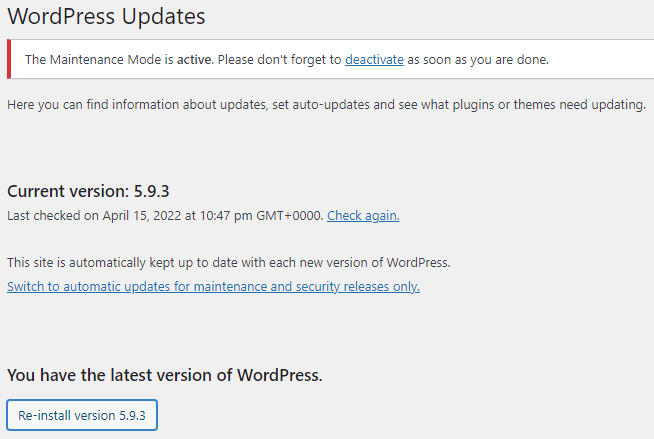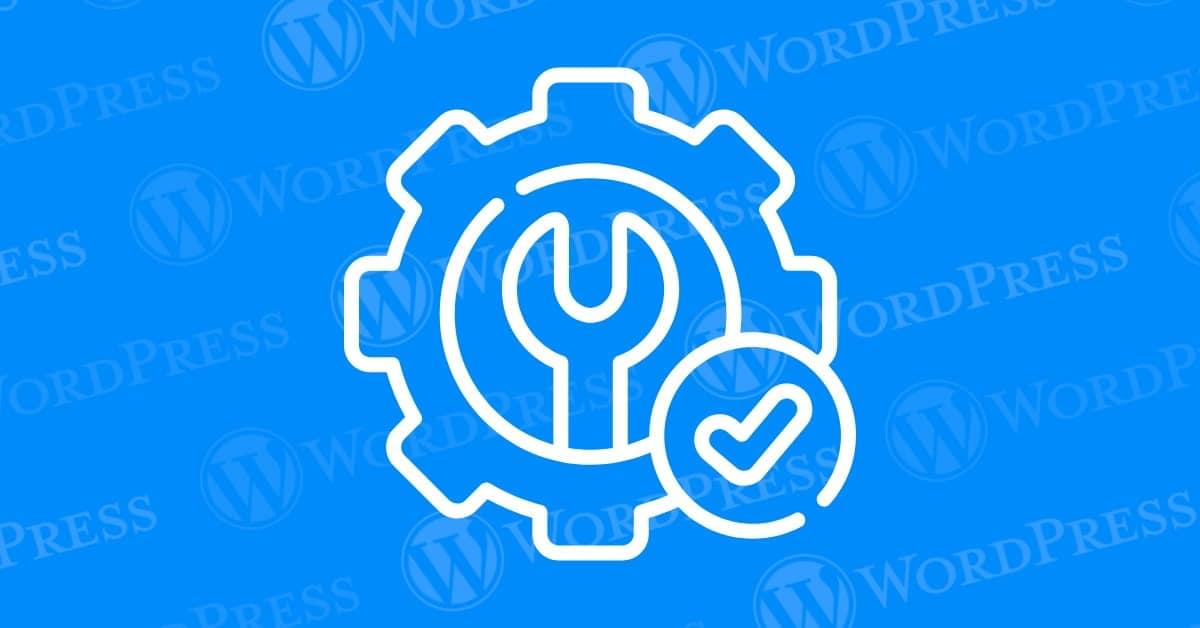As with any software, sometimes you will encounter an issue on your WordPress site where the best solution is a full reinstall. For example, you might be faced with corrupt files, unexplained errors, or accidental changes. With software as complex as WordPress, you never know when you may need a fresh reinstall to fix an issue.
You can reinstall WordPress quickly and easily from the Updates tab in your Dashboard. If you need to dig deeper, you can manipulate the files in your website’s root directory to replace only the suspect files.
- Why You Might Need to Reinstall WordPress
- What Precautions Should I Take Before Reinstalling WordPress?
- How To Reinstall WordPress Without Losing Data (In 4 Steps)
- What Automated Tools Can be Used For Backups And Software Reinstallation After A Compromise?
- Are There Any Specific Steps Recommended To Protect A WordPress Website Using Jetpack Security?
- How Can Jetpack Security Help In Real-time Backups, Restores, And Providing Essential Security Tools?
- What Are The Benefits Of Using Jetpack Security For Website Protection?
- How Can A Clean WordPress Installation Help In Case Of Website Compromise?
- Conclusion: Reinstall WordPress Safely and Securely
Reinstalling the core WordPress files can save you time and effort versus troubleshooting all of your site’s files and code looking for errors. With the click of a button or some manipulation in your root directory, you can have your site running a fresh WordPress install free of bugs.
In this article, we will cover the reasons you might need to reinstall WordPress, and discuss how to do so safely. Let’s get started!
Why You Might Need to Reinstall WordPress
Running into an unexpected problem with your website can be scary and frustrating. Sometimes the problem is clear-cut, but other times it can be difficult to pin down the source of the issue and figure out a solution.
For example, if you conduct a WordPress update and afterwards your site is behaving strangely, you know the general cause of the issue. However, you probably don’t want to undo the entire update, and it may not be obvious what caused it to misbehave. You could try troubleshooting all of your plugins and code to look for conflicts, but an easier solution might be to just reinstall WordPress.

If the update was interrupted or an exception occurred during the process, it may simply have been a fluke that corrupted your update. Reinstalling the latest version of WordPress should clear up the issue. Similarly, this can be a simple fix to many problems you might encounter on your website.
What Precautions Should I Take Before Reinstalling WordPress?
When preparing to reinstall WordPress, it’s paramount to take several precautions to ensure a smooth transition and safeguard your website’s data. Here’s a concise guide on the steps you should follow:
- Back up any files you want for the future. Use a reliable tool like VaultPress Backup, which automates the backup process for your site’s content, such as commentsComments are a feature of WordPress that allow users to engage in discussions about the content of a website. ... More, products, and postsA post is a type of content in WordPress, a popular open-source content management system used for creating an... More, and stores them in an offsite location. This ensures that all your vital information is safely backed up in real time.
- Fully remove any questionable files. Before proceeding with the reinstallation, make sure to clean up your site by removing any files or plugins that are outdated or potentially compromised.
- Activate maintenance mode on your site. This prevents your visitors from experiencing broken pagesIn WordPress, a page is a content type that is used to create non-dynamic pages on a website. Pages are typica... More or errors as you work on reinstalling WordPress.
- Reinstall a fresh copy of WordPress and add old data. After reinstalling the core WordPress software (which VaultPress does not back up), you can restore your backed-up content with ease.
- Preserve Custom Configurations: If you’ve added custom code snippets to enhance your theme or functionality, remember to save these separately. Re-adding these customizations after reinstalling WordPress will help maintain your site’s look and functionality without any hitches.
By following these steps, you can confidently reinstall WordPress, knowing your site’s integrity and custom features are preserved.
How To Reinstall WordPress Without Losing Data (In 4 Steps)
While reinstalling WordPress can be beneficial, you do risk losing data or changing settings that you have fine-tuned over time. WordPress is the backbone of your website, so you need to be very careful when removing it to ensure that you will be able to put it back the same way.
It is better to be too careful during this process than to risk losing content along the way. The last thing you want to do is create more problems for yourself by losing data during reinstallation!
Step 1: Back Up Your Important Files
For peace of mind, it is always a good idea to back up your website before making any significant changes to it. In addition to a full backup, it may also be a good idea to export any data that is extra sensitive or would be easier to import back in from an external source.
Fortunately, WordPress does a good job of grouping like content together. If you know where to look, you can easily find all of the data for your plugins, WordPress settings, and more:

A more hands-on approach for creating backups is to simply locate and copy these files into a temporary folder where they can be moved back after reinstalling WordPress. For example, you can find all of your pluginA plugin is a software component that adds specific features and functionality to your WordPress website. Esse... More data by logging into your site via File Transfer Protocol (FTP) and looking under the /public/wp-content/plugins/ folder. Simply copy it to a safe place for a backup of all your installed plugins.
The more exhaustive approach is to run a dedicated backup of your entire website. This can be done with a plugin such as Jetpack, or your hosting service may already run regular backups for you. With a full backup of your website, you can revert back to a previous version in the event that something else goes wrong.
Step 2: Remove Unwanted or Suspect Files
If you suspect that any particular files may be the cause of the error you’ve encountered, you can take them out before reinstalling WordPress to ensure that they are eliminated. For example, if you see any corrupted files in your site’s root directory, you should try to determine what they are and then delete them prior to reinstallation (if necessary).

While the reinstallation process should overwrite any corrupt WordPress files, removing them at this stage ensures that they won’t interfere with the process or rear their ugly heads in the future. You should also keep an eye out for corrupt or malicious files outside of WordPress core, such as in plugins or themesA WordPress theme is a set of files that determine the design and layout of a website. It controls everything ... More, as these could be causing problems with your site.
You may want to run another backup after removing any unwanted files, or even test your site without them. If you think a corrupt file is causing the issue, you can even attempt to replace it by itself instead of performing a full reinstall.
Step 3: Activate Maintenance Mode on Your Site
Before moving ahead with the reinstallation process, or if your site is already down from the errors you are troubleshooting, you’ll want to activate maintenance mode. This will let your visitors know what is going on, and could imply that the downtime is intentional. It is much better for your visitors to see that your site is under maintenance than to receive an error or see that your site is broken.
The SeedProd plugin makes it easy to switch your site into maintenance mode. It also allows you to customize your maintenance mode page to create a more informative and attractive landing page for your audience:

Simply flip the switch to activate maintenance mode before beginning the reinstallation process, and turn it back off once everything is up and running again. You could even modify the page with a message explaining the issue or giving an estimated time when things will be back to normal.
Step 4: Reinstall WordPress
There are a few methods for reinstalling WordPress, depending on how deeply you need to manipulate your files. The easiest option is as simple as clicking the Reinstall button in the Updates menuIn WordPress, a menu is a collection of links that are displayed as a navigation menu on a website. Menus are ... More:

This will simply reinstall the latest version of WordPress core as if it were an update:

However, while this method can overwrite corrupted files, it may not be enough to solve your problems. For a more thorough reinstall, you can manually remove all of the files from your root directory via FTP, and then install a fresh copy of WordPress.
In this case you can either install the newest version of WordPress, which may help resolve your issues, or reinstall your current version. As we discussed earlier, be sure to have a backup of any important files or content you will want to add back afterward.
For example, if you don’t think the problem is related to your plugins or themes, you can make a copy of the /wp-content/ folder so you can add it back after reinstalling. Other files worth saving are wp-config.php and wp-settings.php, as these include site settings you would otherwise have to reconfigure after reinstallation. Note that if any of these files are related to the issues with your site, adding them to your new installation may recreate the problem.
What Automated Tools Can be Used For Backups And Software Reinstallation After A Compromise?
When your website suffers from a security breach, quick restoration is essential. Automated tools can simplify the process of backing up and reinstalling your software, particularly for WordPress sites. Here are some top automated tools for restoration and security:
Automated Tools for Restoration and Security
- Jetpack: Jetpack is highly recommended for WordPress users seeking a comprehensive solution. It offers real-time backup services, enabling you to restore your site to any previous state effortlessly. Additionally, Jetpack’s security suite includes a firewall and malware scanning to protect your site from future attacks.
- UpdraftPlus: UpdraftPlus excels in providing both scheduled and on-demand backups, which are stored in the cloud. This ensures that you can easily access and reapply these backups during reinstallation, keeping your content up-to-date and secure.
- BackupBuddy: BackupBuddy is designed for seamless WordPress management, offering complete backup solutions that can be scheduled regularly. It stores backups off-site, making it easier to reinstall core software and recover your website after a security incident.
Implementing Automatic Reinstallation
Incorporating these tools into your WordPress management practices can offer peace of mind by significantly reducing downtime and mitigating the impacts of a security breach. By automating backups and utilizing reliable reinstallation features, you ensure a swift and secure recovery process, allowing your site to continue functioning smoothly with minimal interruption.
Are There Any Specific Steps Recommended To Protect A WordPress Website Using Jetpack Security?
Jetpack Security offers a powerful suite of tools designed to protect WordPress websites from various threats. This comprehensive package includes essential features that help maintain your website’s integrity and security.
Key Features of Jetpack Security
- Firewall: Serves as the first line of defense against unauthorized access.
- Malware Scanner: Regularly scans your site for malicious code and vulnerabilities.
- Anti-spam Tool: Filters out spam comments and content, preserving your site’s credibility.
Step-by-Step Guide to Securing Your WordPress Site
- Installation and Activation: Start by installing and activating the Jetpack plugin from your WordPress dashboardIn WordPress, the Dashboard is a central hub for managing a website's content and settings. It is the first sc... More.
- Enable Security Features: Within the Jetpack dashboard, activate critical security features such as real-time backups and malware scanning.
- Regular Updates: Keep your WordPress installation, including themes and plugins, updated to the latest versions to close potential security gaps.
- Automated Backups: Set up automated backups to ensure you can quickly restore your website to a previous state if a breach occurs.
- Monitor and Adjust: Regularly review your security settings and adjust them as needed based on the security reports generated by Jetpack.
Integrating Jetpack Security into your WordPress management routine can significantly reduce the risk of severe security breaches. A proactive approach is crucial: regularly monitor your site’s security status and update your defenses as needed. This combination of preventive and responsive security measures will help maintain your website’s integrity and trustworthiness.
How Can Jetpack Security Help In Real-time Backups, Restores, And Providing Essential Security Tools?
Jetpack Security is an indispensable toolkit for any WordPress website owner, designed to significantly improve your site’s safety and efficiency. Here’s how Jetpack Security excels in providing real-time backups, easy restorations, and comprehensive security tools:
Real-Time Backups Jetpack Security continuously backs up your website’s data as changes occur. This real-time backup feature ensures that any update, whether a new post or a configuration change, is immediately saved. You don’t have to remember to manually back up your site; Jetpack handles it seamlessly in the background, giving you peace of mind and minimizing the risk of data loss.
Easy Restores If your website crashes or you experience data loss, Jetpack Security makes data recovery quick and easy. With just a few clicks, you can restore your website to any previously backed-up state. This feature significantly reduces downtime, helping you maintain reliability and trust with your visitors.
Comprehensive Security Tools Beyond backups and restores, Jetpack Security offers a robust suite of security tools designed to protect your site from various threats. These include:
- Firewall Protection: Automatically defends against unauthorized access and prevents potential security breaches.
- Malware Scanning: Regularly scans your website for malware and vulnerabilities, alerting you to any potential threats.
- Anti-Spam Tools: Filters out harmful or unwanted content automatically, keeping spam under control.
Together, these tools ensure that your WordPress site remains secure, operates smoothly, and stays protected against the ever-evolving landscape of digital threats. By consolidating these functions into one platform, Jetpack Security makes website management both straightforward and efficient.
What Are The Benefits Of Using Jetpack Security For Website Protection?
Jetpack Security is a powerful defense mechanism for your WordPress website, offering a comprehensive suite of tools to shield against a wide range of online threats. Here’s why Jetpack Security is an excellent choice for maintaining your site’s integrity:
- Multifaceted Defense System: Jetpack Security provides a layered protection strategy, including:
- Firewall: Guards against unauthorized access and hacking attempts.
- Malware Scanner: Regularly scans your site to detect and eliminate malware.
- Anti-Spam Tool: Keeps your site clean from spammy content and comments.
- Prevention of Major Issues: Jetpack helps prevent significant WordPress issues such as hacking or severe glitches, which might otherwise require a complete overhaul or reinstallation. This proactive approach saves you time and prevents potential losses.
- Automated Backup and Restoration: One of Jetpack’s standout features is its real-time backups and easy restoration. If something goes wrong, you can quickly restore your website to its previous state, minimizing downtime and disruption.
- Comprehensive Protection Post-Recovery: After resolving an issue, it’s crucial to strengthen your site’s defenses. Jetpack ensures your installation is protected by the latest security technology, keeping your restored site safe from future threats.
By integrating Jetpack Security into your WordPress management strategy, you ensure your website remains secure, functional, and resilient against evolving cyber threats. This peace of mind allows you to focus more on content creation and less on technical headaches.
How Can A Clean WordPress Installation Help In Case Of Website Compromise?
A fresh WordPress installation can be crucial for recovering from a website compromise. Whether your site has been hacked or plagued by persistent technical issues, resetting WordPress to its original state can often resolve these problems. Here’s how a clean installation can benefit you:
Step-by-Step Benefits of a Clean WordPress Installation
- Error Resolution: Reinstalling WordPress removes corrupted files and harmful code that may be causing system instability or security vulnerabilities. This fresh start can eliminate persistent errors and restore your site’s functionality.
- Streamlined Process: Modern tools make backing up and reinstalling WordPress straightforward, reducing the technical burden and minimizing downtime. This efficient process ensures your website is up and running quickly.
- Enhanced Security: After a new installation, integrating a robust security plugin like Jetpack can significantly fortify your website’s defenses. Jetpack offers real-time backups, quick restore options, a firewall, and malware scanning, providing comprehensive protection against future threats.
Rebuilding your website with a clean WordPress installation not only addresses current issues but also strengthens your site’s security framework, helping prevent future attacks and ensuring ongoing stability.
Conclusion: Reinstall WordPress Safely and Securely
Now that you know how to reinstall WordPress without losing data, you will be ready for situations when your site is broken or corrupted and needs a refresh. While this hopefully won’t happen often, there are situations when a reinstall can save you a lot of time and stress.
When reinstalling WordPress, remember to follow these steps:
- Back up any files you want for the future.
- Fully remove any questionable files.
- Activate maintenance mode on your site.
- Reinstall a fresh copy of WordPress and add old data.
Do you have any other questions about reinstalling WordPress? Let us know in the comments below!
If you’re looking for fast wordpress hosting as well as done-for-you updates such as reinstalling WordPress, check out our hosting packages by clicking the button below:



